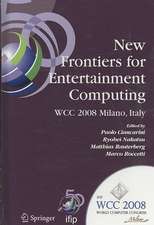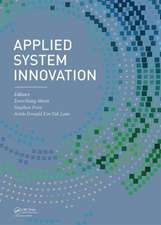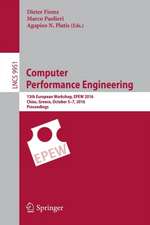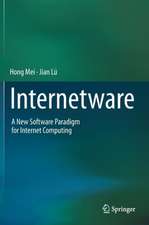Coordination Languages and Models: First International Conference, COORDINATION '96, Cesena, Italy, April 15-17, 1996. Proceedings.: Lecture Notes in Computer Science, cartea 1061
Editat de Paolo Ciancarini, Chris Hankinen Limba Engleză Paperback – 3 apr 1996
Din seria Lecture Notes in Computer Science
- 20%
 Preț: 1061.55 lei
Preț: 1061.55 lei - 20%
 Preț: 307.71 lei
Preț: 307.71 lei - 20%
 Preț: 438.69 lei
Preț: 438.69 lei - 20%
 Preț: 645.28 lei
Preț: 645.28 lei -
 Preț: 410.88 lei
Preț: 410.88 lei - 15%
 Preț: 580.46 lei
Preț: 580.46 lei - 17%
 Preț: 427.22 lei
Preț: 427.22 lei - 20%
 Preț: 596.46 lei
Preț: 596.46 lei -
 Preț: 449.57 lei
Preț: 449.57 lei - 20%
 Preț: 353.50 lei
Preț: 353.50 lei - 20%
 Preț: 1414.79 lei
Preț: 1414.79 lei - 20%
 Preț: 309.90 lei
Preț: 309.90 lei - 20%
 Preț: 583.40 lei
Preț: 583.40 lei - 20%
 Preț: 1075.26 lei
Preț: 1075.26 lei - 20%
 Preț: 310.26 lei
Preț: 310.26 lei - 20%
 Preț: 655.02 lei
Preț: 655.02 lei - 20%
 Preț: 580.93 lei
Preț: 580.93 lei - 20%
 Preț: 340.32 lei
Preț: 340.32 lei - 18%
 Preț: 938.83 lei
Preț: 938.83 lei - 20%
 Preț: 591.51 lei
Preț: 591.51 lei - 15%
 Preț: 438.59 lei
Preț: 438.59 lei - 20%
 Preț: 337.00 lei
Preț: 337.00 lei -
 Preț: 389.48 lei
Preț: 389.48 lei - 20%
 Preț: 607.39 lei
Preț: 607.39 lei - 20%
 Preț: 1024.44 lei
Preț: 1024.44 lei - 20%
 Preț: 579.30 lei
Preț: 579.30 lei - 20%
 Preț: 763.23 lei
Preț: 763.23 lei - 20%
 Preț: 453.32 lei
Preț: 453.32 lei - 20%
 Preț: 575.48 lei
Preț: 575.48 lei - 20%
 Preț: 585.88 lei
Preț: 585.88 lei - 20%
 Preț: 825.93 lei
Preț: 825.93 lei - 20%
 Preț: 763.23 lei
Preț: 763.23 lei - 17%
 Preț: 360.19 lei
Preț: 360.19 lei - 20%
 Preț: 1183.14 lei
Preț: 1183.14 lei - 20%
 Preț: 340.32 lei
Preț: 340.32 lei - 20%
 Preț: 504.57 lei
Preț: 504.57 lei - 20%
 Preț: 369.12 lei
Preț: 369.12 lei - 20%
 Preț: 583.40 lei
Preț: 583.40 lei - 20%
 Preț: 343.62 lei
Preț: 343.62 lei - 20%
 Preț: 350.21 lei
Preț: 350.21 lei - 20%
 Preț: 764.89 lei
Preț: 764.89 lei - 20%
 Preț: 583.40 lei
Preț: 583.40 lei - 20%
 Preț: 649.49 lei
Preț: 649.49 lei - 20%
 Preț: 341.95 lei
Preț: 341.95 lei - 20%
 Preț: 238.01 lei
Preț: 238.01 lei - 20%
 Preț: 538.29 lei
Preț: 538.29 lei
Preț: 340.82 lei
Preț vechi: 426.03 lei
-20% Nou
Puncte Express: 511
Preț estimativ în valută:
65.21€ • 68.27$ • 53.96£
65.21€ • 68.27$ • 53.96£
Carte tipărită la comandă
Livrare economică 05-19 aprilie
Preluare comenzi: 021 569.72.76
Specificații
ISBN-13: 9783540610526
ISBN-10: 3540610529
Pagini: 468
Ilustrații: XI, 452 p.
Dimensiuni: 155 x 235 x 25 mm
Greutate: 0.65 kg
Ediția:1996
Editura: Springer Berlin, Heidelberg
Colecția Springer
Seria Lecture Notes in Computer Science
Locul publicării:Berlin, Heidelberg, Germany
ISBN-10: 3540610529
Pagini: 468
Ilustrații: XI, 452 p.
Dimensiuni: 155 x 235 x 25 mm
Greutate: 0.65 kg
Ediția:1996
Editura: Springer Berlin, Heidelberg
Colecția Springer
Seria Lecture Notes in Computer Science
Locul publicării:Berlin, Heidelberg, Germany
Public țintă
ResearchCuprins
Parallel multiset processing: From explicit coordination to chemical reaction.- Graph rewriting and constraint solving for modelling distributed systems with synchronization (extended abstract).- Coordination as constrained interaction (extended abstract).- The IWIM model for coordination of concurrent activities.- Sonia: An adaptation of Linda for coordination of activities in organizations.- The ToolBus coordination architecture.- Enhancing coordination and modularity mechanisms for a language with objects-as-multisets.- Towards a compositional method for coordinating Gamma programs.- Introducing a calculus for higher-order multiset programming.- ?2Log: Towards remote coordination.- A process algebra based on Linda.- Intra- and inter-object coordination with MESSENGERS.- Ariadne and HOPLa: Flexible coordination of collaborative processes.- Coordination in the ImpUnity framework.- Compiler correctness for concurrent languages.- A software environment for concurrent coordinated programming.- Designing a coordination model for open systems.- CCE: A process-calculus based formalism for specifying multi-object coordination.- An extensible framework for the development of coordinated applications.- Broadcasting in time.- Semantics of a higher-order coordination language.- Solving the Linda multiple rd problem.- Coordinating distributed objects with declarative interfaces.- Coordinating services in open distributed systems with Laura.- Visifold: A visual environment for a coordination language.- ALWAN: A skeleton programming language.- Weaving the Web using coordination.- Investigating strategies for cooperative planning of independent agents through prototype evaluation.- A case study of integration of a software process management system with software engineeringenvironments for process monitoring and management.- Nepi: A network programming language based on the ?-calculus.- Modelling interoperability by CHAM: A case study.- Integrating coordination features in PVM.- A simulator framework for embedded systems.- Understanding behavior of business process models.

























